
USNS Yukon (T-AO-202) is a Henry J. Kaiser-class underway replenishment oiler operated by the Military Sealift Command to support ships of the United States Navy.
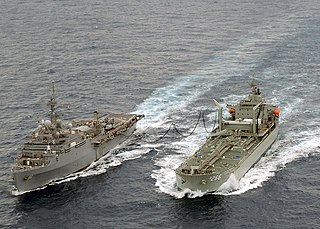
A replenishment oiler or replenishment tanker is a naval auxiliary ship with fuel tanks and dry cargo holds which can supply both fuel and dry stores during underway replenishment (UNREP) at sea. Many countries have used replenishment oilers.

The Henry J. Kaiser class is an American class of eighteen fleet replenishment oilers which began construction in August 1984. The class comprises fifteen oilers which are operated by Military Sealift Command to provide underway replenishment of fuel to United States Navy combat ships and jet fuel for aircraft aboard aircraft carriers at sea. One ship, operated by the United States from 1987 to 1996, was sold to Chile in 2009 and commissioned into the Chilean Navy in 2010; and two ships were scrapped in 2011 while still incomplete.

USNS Rappahannock is a Henry J. Kaiser-class underway replenishment oiler operated by the Military Sealift Command to support ships of the United States Navy.
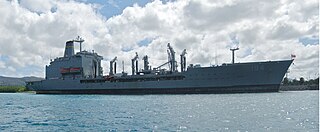
USNS John Ericsson (T-AO-194) is a Henry J. Kaiser-class underway replenishment oiler operated by the Military Sealift Command to support ships of the United States Navy.
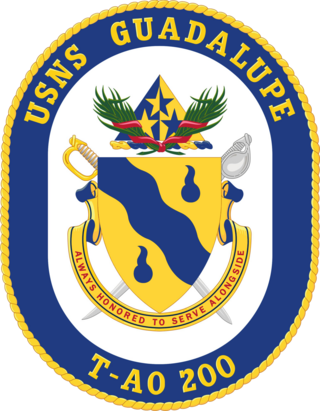
USNS Guadalupe (T-AO-200) is a Henry J. Kaiser-class underway replenishment oiler operated by the Military Sealift Command to support ships of the United States Navy.

USNS Tippecanoe (T-AO-199) is a Henry J. Kaiser-class underway replenishment oiler operated by the Military Sealift Command (MSC) to support ships of the United States Navy. She serves in the United States Pacific Fleet. Tippecanoe, the thirteenth ship of the Henry J. Kaiser class, was laid down at Avondale Shipyard, Inc., at New Orleans, Louisiana, on 19 November 1990 and launched on 16 May 1992. She entered non-commissioned U.S. Navy service under the control of the MSC with a primarily civilian crew on 8 February 1993.

USNS Joshua Humphreys (T-AO-188) is a Henry J. Kaiser-class replenishment oiler of the United States Navy. She was named for Joshua Humphreys, who designed the six original US Navy frigates. She entered service in 1987 and was placed in reserve just nine years later, but has twice been brought out of reserve and as of 2015 is once more on active duty.

USNS Henry Eckford (T-AO-192) was a Henry J. Kaiser-class fleet replenishment oiler of the United States Navy. She was never completed.

USNS Kanawha (T-AO-196) is a Henry J. Kaiser-class fleet replenishment oiler of the United States Navy in non-commissioned service in the Military Sealift Command.
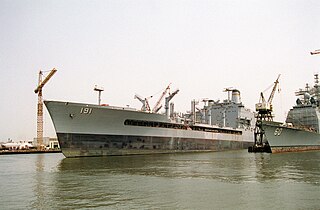
USNS Benjamin Isherwood (T-AO-191) was a Henry J. Kaiser class fleet replenishment oiler of the United States Navy. She was never completed.
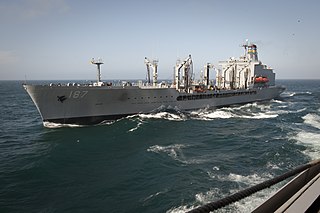
USNS Henry J. Kaiser (T-AO-187) is a United States Navy fleet replenishment oiler and the lead ship of her class. Her mission is to resupply U.S. Navy and allied ships at sea with fuel oil, jet fuel, lubricating oil, potable water, and dry and refrigerated goods, including food and mail.

USNS Leroy Grumman (T-AO-195) is a Henry J. Kaiser-class replenishment oiler of the United States Navy.

USNS Big Horn (T-AO-198) is a Henry J. Kaiser-class replenishment oiler of the United States Navy.

USNS Patuxent (T-AO-201) is a Henry J. Kaiser-class underway replenishment oiler operated by the Military Sealift Command to support ships of the United States Navy.

USNS Laramie (T-AO-203) is a Henry J. Kaiser-class underway replenishment oiler operated by the Military Sealift Command to support ships of the United States Navy.
The Naval Fleet Auxiliary Force is a division of the US Navy. The 42 ships of the Military Sealift Command's Naval Fleet Auxiliary Force are the supply lines to U.S. Navy ships at sea. These ships provide virtually everything that Navy ships need, including fuel, food, ordnance, spare parts, mail and other supplies. NFAF ships enable the Navy fleet to remain at sea, on station and combat ready for extended periods of time. NFAF ships also conduct towing, rescue and salvage operations or serve as floating medical facilities. All NFAF ships are government owned and crewed by civil service mariners. Some of the ships also have a small contingent of Navy personnel aboard for operations support, supply coordination and helicopter operations.

USNS John Lewis (T-AO-205) is a United States Navy replenishment oiler and the lead ship of her class. She is part of the Military Sealift Command fleet of support ships.

The John Lewis class is a class of fleet replenishment oilers which began construction in September 2018. The class will comprise twenty oilers which will be operated by Military Sealift Command to provide underway replenishment of fuel and limited amounts of dry cargo to United States Navy carrier strike groups, amphibious ready groups, and other surface forces to allow them to operate worldwide.


















